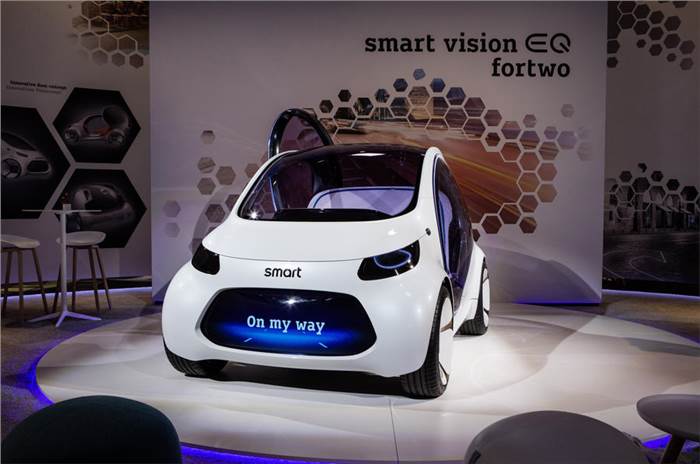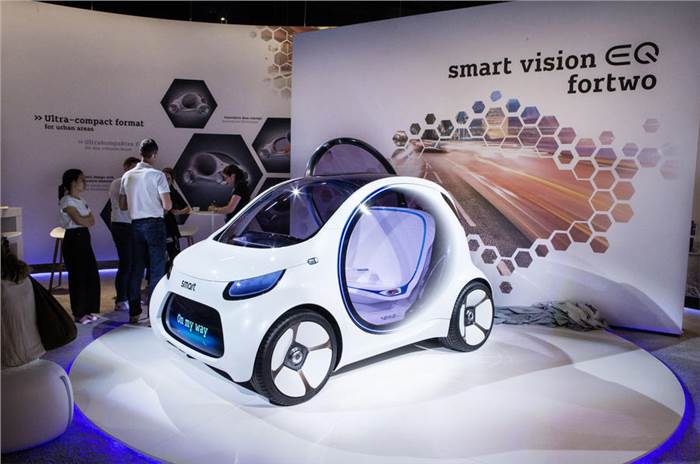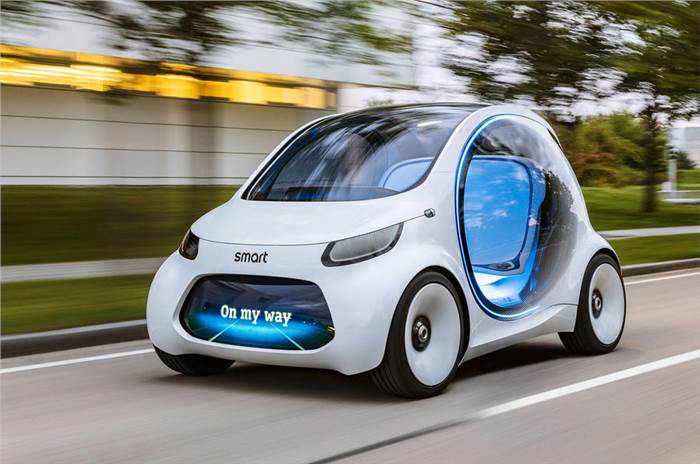Smart has recently unveiled its electric Vision EQ Fortwo providing an insight into how it expects city cars, urban mobility solutions and car-sharing models to progress in the future.
The Vision EQ will make its public debut at the Frankfurt motor show, the self-driving two-seater showcases the technologies that Smart boss, Annette Winkler, says are being considered for the company's future city car models. The models will also play a key role in parent company Mercedes-Benz’s Car2Go car-sharing programme by 2030.
“The Smart Vision EQ Fortwo is our vision of future urban mobility; fully autonomous, with maximum communication capabilities and electric,” says Winkler.
The highlight of the all-electric concept is an advanced Level 5 autonomous driving system. It is integrated with swarm intelligence that Smart suggests will make future models and associated car-sharing fleets more convenient and efficient by better anticipating the predictability of demand.
“In the future, car-sharing users will not have to look for the next available car – it will find them and collect passengers directly from their chosen location,” says Winkler.
The adoption of autonomous driving technology in the development of its Car2Go scheme is a vital part of Smart’s growth plans. Currently, a Smart model is hired every 1.4sec in cities around the world through a customer base of more than 2.6 million. The company says internal studies predict the number of users of car-sharing schemes worldwide will increase fivefold by 2025 to more than 36.7 million customers.
Smart is expected to have exclusively electric models in its line-up in the future and will sell them under the Mercedes-Benz EQ all-electric sub-brand. Confirmation should arrive by next year’s Geneva motor show. The Vision EQ Fortwo features a rear-mounted electric motor and 30kWh lithium-ion battery offering a range of “well over 300km”.
When not being used, Smart sees the two-seater to use its self-driving ability to go to a charging station, where its battery can be charged though inductive means, without the need to plug it in.
A pod-like safety cell used as the body provides clues to how Smart plans to evolve the high-strength steel Tridion structure used by all of its models since the company’s inception in 1998. The Vision EQ concept features a one-and-a-half-box design expected to influence the styling of the next generation of Smart models.
The overall appearance is rounder than the current-gen Smart models. T most prominent features are its heavily curved roofline, large wheel houses and ovoid-shaped doors.
A continuation of the design of previous Fortwo models, the concept car’s 18-inch wheels are set at each corner, providing it with the largest possible footprint in a move aimed at maximising interior accommodation.
With a length of 2699mm, width of 1720mm and height of 1535mm, the new concept car is the same length but 50mm wider and 25mm lower than the current third-gen Fortwo.
“The Vision EQ Fortwo is a radical approach,” says Mercedes-Benz’s chief design officer, Gorden Wagener. “It has the hallmark Smart proportions with accentuated wheel arches and no overhangs, as well as the next level of communication and personalisation."
New design elements include a new front end with a curvy headlight design and a large trapezoidal-shaped grille – both with black panel displays that Smart claims will allow future models to provide greater personalisation and communication functions. A graphic within the headlights mimics the blinking of an eye when passengers approach, while the grille can display messages to prospective ride-sharing customers.
Smart predicts future urban mobility models will see cars summoned via smartphone and says the integration of black panel technology, which is also used on the Mercedes-Benz EQ C electric car concept, will allow future models to display information not only meant for car-sharing customers but other road users.
The black panel monitors are designed to indicate whether the car is occupied by one or two passengers. Smart proposes that those wanting to use the sharing function can make contact with other users via a saved profile and travel plans, and can be accepted or rejected by the prime customer.
Just like the current Fortwo, the concept car has a defined bonnet with the front end structure used as a deformation zone for added safety. The tail gets a deep, two-piece glass tailgate and high-set LED tail-lights designed to carry either a conventional look or provide information on traffic jams or possible delays.
To help with parking and reduce the danger of colliding with pedestrians, the two round electrically operated doors pivot backwards parallel to the sides of the car over the rear wheels, revealing a large aperture through which to climb aboard into the flat-floored cabin.
In the cabin, the Vision EQ features a minimalistic design without a steering wheel, pedals or traditional controls. Everything is controlled via smartphone or voice control. Occupants sit on a lounge style seat featuring a retractable centre armrest.
A wrap-around windscreen and glass doors that can change between clear and an opaque provide all-round vision. Information is displayed on a 24-inch high-definition screen mounted beneath the windscreen. Smart envisages the doors of the new concept will also display information, such as news, local events and weather, turning it into a mobile billboard.







Comments
Member Login
Personal Details
No comments yet. Be the first to comment.